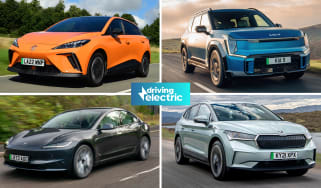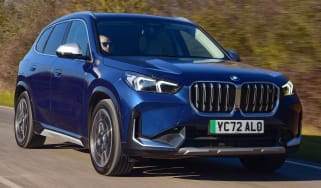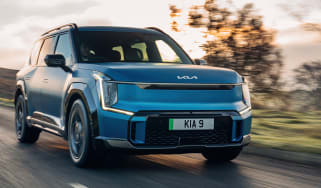Fisker Ronin: electric convertible revealed with 600-mile range
CEO says convertible EV will do over 600 miles, but it’ll be “ultra-luxury priced and built in limited quantities”
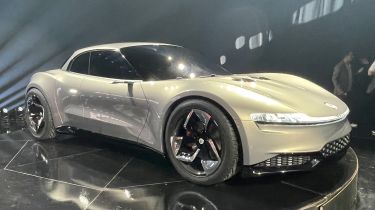
Completing a trio of new EVs shown at the first Fisker Product Vision Day, was the Fisker Ronin electric convertible. Debuting alongside the Fisker PEAR small car and Fisker Alaska pickup, the electric sports car is expected to go on sale in mid-2025.
American electric-car maker Fisker revealed in 2022 that it’d been working on a four-door convertible GT car with a range of over 600 miles. CEO and founder Henrik Fisker initially shared the news on social media, adding that the flagship model would be capable of 0-60mph in close to two seconds, thanks to a combination of three electric motors.
Now the car has been revealed in full, with Fisker reiterating those stats and telling onlookers the Ronin will be “ultra-luxury priced and built in limited quantities”. Speaking with DrivingElectric, the boss said: “It’ll be handbuilt, and we’re only talking less than 1,000 units.”
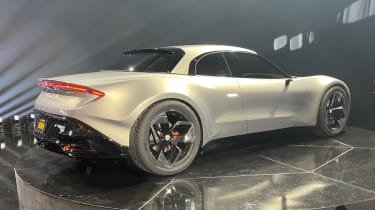
Fisker calls its new sports car a “true five-seat GT”. It gets a carbon fibre retractable hard-top and four butterfly doors – two more than any convertible currently in production. Adding to this, Fisker said the car will get a “high-tech luxury interior”, though we’re yet to get a glimpse inside the exclusive model.
The car that made its debut at Fisker’s event in Los Angeles was a striking silver colour, with slim headlights and full-width front and rear light bars. The wheelbase is accentuated thanks to the fact the entire cabin sits between the front and rear axle; the long bonnet and unusually lengthy bootlid give it a look clearly inspired by the now defunct Fisker Karma plug-in hybrid saloon car. Like the previous Ronin sketches, the production car will sport a set of digital side mirrors to help with aerodynamics.
On the subject of a future Tesla Roadster rival, Fisker previously said: “The aim first of all was to say ‘what’s happening with sports cars in the future?’
“It might be one of the difficult transitions, because a large part of a sports car is about sound, the interactions and the mechanics with the engine – gearshifts, kickdown and all that – and that’s what brings the sense of occasion. Now, how do we create that sense of occasion when you’re driving an electric sports car? That’s number one,” he said.
“Number two is, where do we exactly think sports cars are going? If I look at the environment today, yes, people still like sports cars, but they end up driving big SUVs… people just seem like they are looking more for usability in their everyday driving.”
Fisker added: “We wanted to resist making another super-SUV at this point in time, I’m not saying we wouldn’t do it, but for this sports car, our thinking was ‘how do we make a future sports car?’.”
One key component of making the car usable is the Ronin’s impressive range figure, which Fisker previously told us will be achieved with a new battery design integrated into the car's structure. The advantage of doing this, Fisker says, is a larger battery volume for the car, while leaving enough room inside to comfortably seat four adults and their luggage.

He added: “we also have a unique roof mechanism that allows it to be either a convertible or a sports sedan… So in that sense, it’ll probably be the most usable convertible in the world, because it’s got four doors. It’s not the easiest thing to do, because we had to make a unique structure to make it stiff enough to make that happen.”
Fisker himself has excellent form when it comes to designing sports cars, having styled the Aston Martin Vantage, Aston Martin DB9 and BMW Z8 before creating his own brand. In terms of the Ronin’s looks, Fisker described it as “extremely radical” and “very dramatic, very sculpted”. He added “I think what we love about sports cars is these dramatic proportions, and it used to be ‘flat, mid-engined, WOW’.
“But we moved away from that, because for me, to just make another mid-engined-looking electric car doesn’t make sense… there was a reason why mid-engined cars were like that, because the engine was so big, you put it behind the seats and you could make everything flat… we went for something else.”
As mentioned, we’ve yet to see pictures of the Ronin’s interior, but Fisker did reveal that he wanted “the most sensual, luxurious interior, without relying on a million stitches and eight cowhides.
“There has to be something else,” he said. “So it’s a very dramatic interior that I think really is there to stimulate your sense of ‘wow, this is special, I’m sitting in something so unique, so sexy, so cool’ and that’s really what it was about.
“It’s appealing to, in my view, why we fell in love with cars in the first place and why we keep wanting to fall in love with cars. But we are pursuing enough usability that you can argue to yourself or your spouse why you should buy this car.”
The Ronin will be the fourth model in Fisker’s growing range of electric cars. The first, the Tesla Model Y-rivalling Ocean SUV, is on sale now, while the PEAR small car and Alaska pickup are both due in 2025, shortly before Ronin production commences.
Recommended

Porsche Macan EV: BMW iX rival gets Taycan-inspired interior

MINI Cooper Electric: pricing and specs for British-built electric supermini
Most Popular

Morgan Super3 XP-1 is an electric three-wheeler

MINI Cooper Electric: pricing and specs for British-built electric supermini

